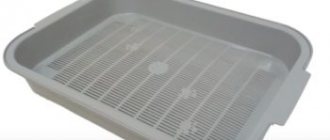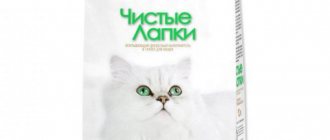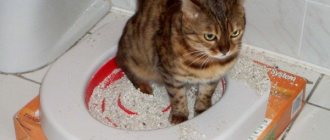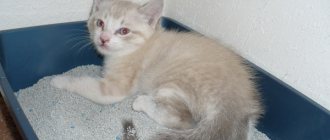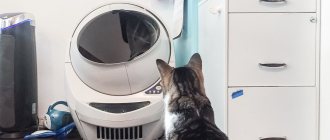Cat toilet - how to organize it correctly?
Cat litter is one of the most important tasks for a pet at home. The right litter, a comfortable place and toilet training for your pet play a big role in organizing home comfort. It’s easier if you can take your pet for a walk, but even here it’s important to organize the walk properly, taking into account the terrain.
Fillers for trays today are varied:
- these are granular clumping and non-clumping clay fillers,
- sawdust, shavings, plant husks,
- sand,
- paper fillers,
- flavored and unflavored fillings.
The choice, of course, remains with the pet, who may be picky.
Reasons why a pet does not use the litter box or makes a mistake
:
- the pet is sick or getting old,
- the owner replaced the usual filler with another one, the owner updated the tray, the owner cleans and washes the tray with a sanitary product with a subtle odor, but the animal is sensitive to the smell,
- the owner has rearranged the house and the animal does not know the way to the tray,
- stress in the animal from the presence of new family members, guests, other animals.
The choice of litter for the tray should be considered. Clumping granular litters are convenient because they do not need to be completely changed, but only remove the lumps formed by urine and add new portions of the filler. Make a complete replacement, for example, once a week.
The smell of shavings and plant components can repel animals, as well as flavorings.
What is convenient for the owner may be unacceptable for the animal.
The shape and dimensions of the tray also matter. There are closed and open trays, but not every animal will use a closed tray (this is not an acquired taste). The height of the side of the litter tray matters. For some animals, the edge may be higher than necessary and create trouble. The width of the tray should allow the animal to dig around in the tray if it is accustomed to doing so. Messiness in the litter box may be caused by insufficient space in the litter box, and not by the pet's lack of neatness.
Water and drinking bowl
Many people complain that their pet drinks little water, and also ignores his water bowl and drinks in a completely different place: for example, licking the remaining water in the bathroom. Do not place a water bowl in the same place as your cat's food bowl. In the wild, big cats (lions, tigers, etc.) never drink water where they have eaten prey, as they are afraid of getting poisoned.
The same behavior is inherent in domestic cats, because natural instincts live in them. You can place the drinking bowl away from the food bowl, so that the cat does not have to look for a long time. You should also pay attention to the quality of the water and the drinking bowl itself: perhaps one or the other is not entirely clean. This can also cause your cat to ignore water.
We suggest you read: The cat is sneezing and has snot - what to do, how to treat it at home?
Five mistakes when arranging a cat litter box
When a kitten is brought into the house, the issue of hygiene becomes acute. Cats are capricious creatures, they have their own minds; they ignore a tray they don’t like for secret reasons. Pets are irritated by the smell and litter scattered around. How to find a compromise and avoid mistakes that happen when arranging a cat litter box - let's figure it out.
1. Inconvenient tray design
Manufacturers offer trays of different sizes, rectangular, corner. In most cases, this is an open plastic container above or below. Some individuals prefer high sides in order to dig deep into the filler. Trays are produced with a plastic mesh - but your pet may not like it.
Others willingly use closed models - they give a feeling of security. A closed toilet has disadvantages - a door that needs to be opened; limited internal space. Therefore, you should not be surprised if the cat refuses this model. By the way, the door can be removed.
2. Dirty toilet
Cats are partial to smells, but are often loyal when the owner does not clean for a long time. There is a limit to everything - if your pet makes a puddle nearby, then perhaps you should change the filler and wash the tray. Sanitation rules recommend completely removing the contents once every five days and removing lumps of clay or wet sawdust daily. Do not use liquids containing chlorine or strong-smelling disinfectant solutions to wash the container. They will scare a sensitive pet away from the toilet.
Step-by-step training for toilet training a cat
Accustoming a cat takes place in stages and lasts for 2.5-3 weeks.
Learning process:
- The tray with filler standing near the toilet is raised daily by 2 cm, placing magazines or books under it. If the cat stops going to the toilet, then the next lifting is not carried out. We need to wait until she gets used to the height. On day 11, the tray should be at the same height as the bowl of the plumbing fixture.
- Acquaintance with height and toilet lasts 3 days. Then the container is moved slightly onto the toilet sink.
- On day 15, the tray is completely installed on the plumbing seat. It will turn into a single device, and the cat will take it for granted. Once he gets used to the height and position of the toilet, he will be easier to train.
- The tray with filler and the magazine stand are completely removed on the 17th day. The toilet lid is lifted, the rim is covered with wide tape, and a small pad with filler is installed on top of the tape. Then the lid is lowered.
The new device is ready. The smell of the litter will attract the cat and he will confidently go to the toilet. If he refuses, then you need to leave him alone and let him adapt.
As a result, the pet will gain courage and relieve itself in the place offered to it. The filler is removed gradually, reducing its amount daily.
How to choose a litter box for cats
When an owner chooses a toilet for a pet, he must think through all the details for his own and the cat’s convenience. After all, it will depend on whether the pet will go into it and whether it will be convenient to clean it. When choosing a litter box for your cat, you should first pay attention to the following parameters:
- The relationship between the size of the animal and the future toilet. Often, owners of kittens buy a tray for growth, and the animals suffer while overcoming the high sides.
- Pet's love of digging. This parameter will depend on: the weight of the tray - a heavy toilet is more difficult to move when moving the paws;
- the use of filler necessitates the selection of a special tray;
- purchasing a mat - some owners use this accessory so that the cat, when leaving the toilet, leaves granules stuck to its paws on it.
- absence of odor - in case of frequent departures of the owner from the house, an unpleasant aroma will appear from the cat litter placed in the center of the home, no matter what filler is used;
Plastic container
You need to purchase a large plastic container at any hardware or hardware store. In this case, you don’t even need a tray; the filler can be poured directly into the container. Make a small cutout as a door and the tray is ready. The advantage is that it is a closed design, which allows odors to spread less. This toilet option is inexpensive and can fit into the interior if you choose the right color.
Types of cat litter
There are not many types of cat litter on the market, but each of them is aimed at certain buyers.
Tray with low sides
The classic type of cat litter is presented in the form of a trough with small sides on which a mesh is attached. Through the holes, urine flows into the filler, and feces remain directly on the “obstacle”.
Low-sided trays have gained popularity due to their versatility
- small size;
- possibility of placement in the toilet;
- high hygiene;
- efficiency;
- easy cleaning;
- suitable for kittens.
- presence of odor;
- filler cannot be used;
- prompt cleaning is required;
- not suitable for heavy cats.
Tray with high sides
This product requires the use of filler. The sides prevent it from scattering around the room when the pet scoops up waste products with its paws. Such models are equipped with a special film. It is attached to the sides. As soon as there is a need to change the filler, just carefully remove the film and throw it in the trash, and install a new consumable in its place. At the same time, the product itself remains completely clean.
A tray with high sides requires the use of filler
- possibility of using filler;
- cleanliness (the filler is not scattered throughout the room);
- additional tools can be built into the board;
- no smell.
- high cost;
- quite large size (not suitable for installation in cramped bathrooms);
- not suitable for training kittens due to the high altitude.
Closed toilet (dry toilet)
A closed toilet allows the kitten to feel protected. The owners are pleased with the aesthetics of the design. As a rule, the manufacturer equips the model with a special door through which the pet gets inside, but some owners remove it. They believe that this will be better for the animal. Having chosen such a model, the owner wonders how much this miracle costs. And having learned the price, he thinks about whether such a design is really necessary.
An enclosed toilet is important for shy cats
- no odor;
- will look neat anywhere in the house;
- possibility of using filler.
- high cost;
- difficult cleaning;
- not suitable for kittens and large breeds of cats;
- the presence of a door scares animals;
- some four-legged friends use this model not for going to the toilet, but for living;
- You need to put in extra effort to train it.
To increase hygiene, this type of tray can be equipped with a carbon filter. For example, in models from the manufacturer Ferplast. The operating principle is as follows: polluted air rises to the tray lid, into which a special filter is mounted, where it is cleaned of unpleasant odors and organic particles.
A toilet option can also be presented where the bottom of the structure has a grate and an antibacterial mat. Such know-how works correctly only with a special filler, which allows moisture to pass down and thereby starts the disinfection process.
Cat toilet with drainage: models, operating principle, cost
Toilet for cats with drainage "CatGenie 120"
The most popular automatic toilet for cats with drainage is called "CatGenie 120" and is a round toilet with a special washable filler. The liquid is flushed down the drain immediately after the pet goes to the toilet, and the feces are first collected with a scoop with holes and crushed, and then removed. Next, the toilet bowl and granules are washed with soapy water and dried under warm air. The price of this system ranges from 30–35 thousand rubles.
Touch automatic toilet "Kopfgescheit"
More affordable (costing about 10 thousand rubles) is the Kopfgescheit sensor automatic toilet. The cleaning function starts 15 seconds after the pet leaves the toilet. The duration of drainage depends on the type of waste: to clean the container from urine, the system operates for 4 seconds, from feces - 6 seconds. This automatic toilet does not require any filler to use, but it does require more water to flush than the previous model.
Although self-cleaning, smart cat litter boxes need to be cleaned periodically. You need to regularly wipe these “robots” with a cloth soaked in soapy water.
In order for them to last as long as possible, they need to be cleaned every six months, as plaque forms in the system and wool, dirt, etc. accumulate. Special gels are used for cleaning, but in no case are cleaning products with abrasive particles.
How to make a comfortable tray for your pet with your own hands?
It is preferable to make a rectangular box in which it is most convenient for the pet to fit. Regardless of the model chosen, the depth of the container for an adult cat should be within 5–8 cm. It is better to use plastic for its manufacture, since metal oxidizes, and wood gets wet and absorbs unpleasant odors. How to make a cat litter box yourself?
Plastic toilet similar to a regular tray
To work, you need to prepare tape or a marker, a hacksaw or jigsaw, coarse sandpaper or a file, acrylic paint, a plastic container - a construction basin or a medium-sized bath. To make a tray, you need:
- mark the cut location on the wall of the container - the height of the future box, depending on the size of the cat;
- carefully, so that the plastic does not crack, cut off the excess;
- file the edges so that the animal does not get hurt;
- if desired, paint the product.
To make a closed toilet with minimal financial and time costs, you can take a plastic box with a lid and make a hole in one of its walls through which the animal should easily pass. The edges of the passage also need to be filed. When choosing a container, you need to check whether the pet can sit and turn around freely in it.
Cat litter box hidden in a house or cabinet
The tray can be hidden in a cabinet in the hallway or in the house. It is necessary to treat the inner surface with a special agent or line the inside with a material with water-repellent properties, and make a hole in the door for entry. You can buy a house at a pet store or make it yourself. First, it is recommended to make a mock-up of cardboard to determine the size of the shelter and understand whether the animal generally likes a closed toilet, and only then decide on choosing a permanent structure.
Closed cat litter box with door
You can buy or make a wooden box yourself. An enclosed rectangular toilet can be installed in the hallway and used as a storage place for shoe care products, brushes, keys and other small items. To make it, you need to prepare sheets of plywood or wooden boards 1-1.5 cm thick, screws or nails, a hammer, jigsaw or saw, metal corners, sandpaper, small furniture hinges and a water-repellent agent.

